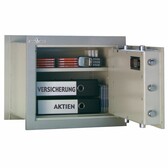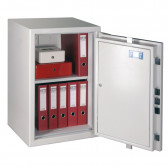More and more people are realising that a safe is a must-have piece of home equipment. With it, you can safely store not only all your valuables but also your firearms. So the only question that remains is where to place the safe best. Mounting a floor or wall safe can be problematic. Finding a place for a free-standing model, on the other hand, is not easy. Find out where best to mount a safe and which model to choose.
Floor or wall mounted safe
Floor or wall mounted safes have recently become more and more popular. This solution has many advantages. First of all, this type of safe is easy to hide. A model mounted in the wall can be covered with a painting or a mirror. The one installed in the floor can be easily covered with panels or a carpet. Moreover, they do not take up free space in the room.
Unfortunately, mounting a safe to the floor or wall requires interference in the structural elements of the building. People living in multi-family houses and blocks of flats do not have the possibility of installing such a model in their flat. Any structural changes require the administrator's consent.
Floor- and wall-installed safes are primarily designed for people living in single-family homes. If you live in an apartment block or multi-family building, opt for a freestanding safe.
Floor and wall versions also have the disadvantage of being much smaller than their freestanding counterparts. If you need a lot of space to store a lot of valuables, buy an armoured cabinet as well.
See also: The wall safe – everything you need to know about it
Installation of a floor safe
The installation of a floor safe must take place in the foundation of the building. It cannot be installed in the ceiling, as there is a danger of damaging the structure of the house. If you have a basement in your house, it will be a good idea to install the safe there. Those who do not have a basement can choose any place on the ground floor of the building.
Fixing a safe to the floor can be difficult, so it is best to decide to install such a safe while the foundation is still being poured. However, if you want to install a safe in an existing building, it is best to use the services of professionals.
Fitting the safe to the floor requires a suitable hole to be drilled. It must be larger and deeper than the safe by approximately 10-15 cm. The safe is fixed with anchors or special screws. The last stage is pouring cement into the free space. Optionally, the concrete can be reinforced with metal bars.
If you have decided to place a floor safe in the basement, make sure that this location is not at risk of flooding due to rising groundwater, precipitation or in the event of a failure of the plumbing system.
Mounting a wall safe
A wall safe cannot be mounted in any wall. It must meet a number of requirements. It needs to have the right thickness and strength of construction. If you have chosen a load-bearing wall as the place for mounting, contact a designer, who will assess whether such interference with the structure is safe.
A wall-mounted safe is assembled in a similar way to a floor-mounted safe. In this case too, a suitable hole must be drilled, 10-15 cm larger than the size of the safe. Then it only remains to anchor the box and pour concrete into the cavity.
The installation may seem simple, but in fact the whole operation can take several hours. You should also bear in mind that you cannot use the safe until the mortar has cured completely. This is likely to take several days.
Where to position the free-standing safe
As you can see, installing a floor and wall safe can be difficult, and in some cases even unfeasible. If you don't want to invite an entire renovation team into your home, choose a freestanding safe.
Remember that you don't have to worry about transporting the armoured cabinet. Hartmann Tresore offers discreet transportation including bringing in, mounting and anchoring the safe. All you have to do is choose a location for your investment.
If you want to be sure that you have chosen the right place for your safe, contact a specialist. Qualified employees will come to inspect the safe on site and assess whether the installation work will go smoothly. Remember that an armoured safe can weigh up to several hundred kilos, so it requires specialist equipment and experience to bring it in and install it.
It is best to place a free-standing safe in a secluded place that is inaccessible to guests and other people. Place an armoured cabinet in a study or bedroom, for example. Try to place the safe away from windows. Thieves often watch the house before robbing it, so don't make it easy for them to find a safe.
Choosing a safe is a difficult and individual matter. You already know what to look for when installing a floor safe and setting up an armored cabinet. Now just consider how large a model you will need. The last point is the choice of lock and burglary resistance class. Do not wait and order your safe today.
Other recommended articles: Floor safe – why choose this one?





